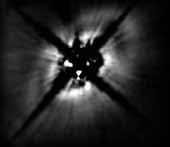|
COMETS EARTH JUPITER KUIPER BELT MARS MERCURY METEORITES NEPTUNE OORT CLOUD PLUTO SATURN SOLAR SYSTEM SPACE SUN URANUS VENUS ORDER PRINTS
PHOTO CATEGORIES SCIENCEVIEWS AMERICAN INDIAN AMPHIBIANS BIRDS BUGS FINE ART FOSSILS THE ISLANDS HISTORICAL PHOTOS MAMMALS OTHER PARKS PLANTS RELIGIOUS REPTILES SCIENCEVIEWS PRINTS
|
Related Documents
Download Options
A striking NASA Hubble Space Telescope near-infrared picture of a disk around the star HD 141569, located about 320 light-years away in the constellation Libra. Hubble shows that the 75 billion-mile wide disk seems to come in two parts: a dark band separates a bright inner region from a fainter outer region. The structure superficially looks much like the largest gap in Saturn's rings - but on a vastly larger scale. The Hubble image, taken at a wavelength of 1.1 microns, was made using the coronagraph in the Near Infrared and Multi-Object Spectrometer (NICMOS) to reduce the glare of the star. The observed radiation from the disk is caused by dust particles which reflect the light of the central star. The dark spikes in the image are regions where there are no useful data due to diffraction artifacts introduced by the optical systems of the telescope and camera. The central portion of the disk remains unseen because of residual glare from the bright star. Credit: Alycia Weinberger, Eric Becklin (UCLA), Glenn Schneider (University of Arizona) and NASA |
